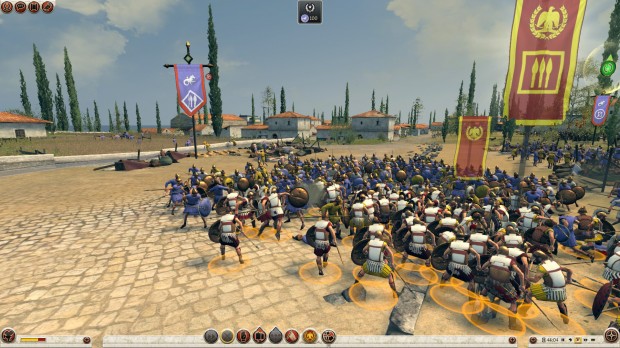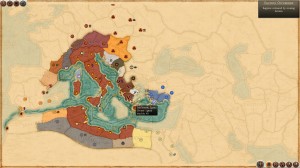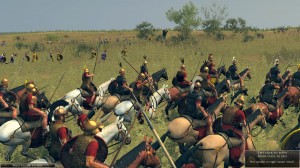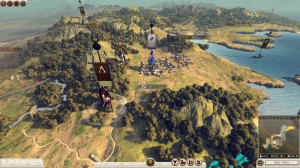Total War: Rome II Single-Player Review (PC)
- Updated: 2nd Sep, 2013

13 years after Creative Labs released their first Total War game, Shogun, their new release hits the market. Total War: Rome 2 is just as polished as you would expect from a SEGA production.
Newcomers will appreciate a very well designed and interesting tutorial, with endless chained encyclopaedic references and tooltips. Once through that, you can get down to the nitty gritty of running the domination of the world.
The strategic world map, from the furthest borders of the Middle East to the opposite side of Western Europe, allows you to choose between several scattered starting nations including the far eastern Parthians past the Caspian Sea, the far northern Icenii in Britain and the Germanic Suebi. On this map you manage your armies, city building, politics, agents and diplomacy.
 The whole map is divided up into provinces comprising two, three or four conurbations, loosely geographically linked, from villages upwards. Political control of a province is only really effective with complete ownership of all of them. This adds an intermediate layer between the city management and nation management section of the game that does increase the complexity. The small amount of town and city sprawls and the large areas they command feels quite claustrophobic initially, but that feeling did subside somewhat when the full scope of the strategic map became apparent and I got some impression of the length of time I’d have to play to be victorious.
The whole map is divided up into provinces comprising two, three or four conurbations, loosely geographically linked, from villages upwards. Political control of a province is only really effective with complete ownership of all of them. This adds an intermediate layer between the city management and nation management section of the game that does increase the complexity. The small amount of town and city sprawls and the large areas they command feels quite claustrophobic initially, but that feeling did subside somewhat when the full scope of the strategic map became apparent and I got some impression of the length of time I’d have to play to be victorious.
Victory has three parallel and equally valid conditions to lead to a win. Military, cultural and economic options are there for those who like a choice of just how they measure their dominance of everyone else in the world. You also have to contend with the internal politics of the Roman state, with your family and faction vying for power and the outcomes do have some effect on the game world, up to and including civil war.
Unfortunately, your opponents are still commanded by what seems a slightly backward AI, who runs away and hides at the wrong time, disperses its units when faced with concentrated force, sits and blockades a virtually undefended city for literally decades at a time with a powerful force and generally fails to follow even the simplest of survival instincts.
There are some pleasant surprises in store, but the oddest failure that struck me was that the AI seems to place the survival of its armies ahead of control of its cities, which, with many of the factions, means their inevitable annihilation. This would make sense if the AI was then using what armies it had to occupy some other weaker territory but they just return in handfuls to beat themselves to death against your replenished force.
Creative Assembly themselves did previously comment that they were using a new “general” system, where you can’t have units on the map without being in an army that has a general to command them, and each faction is restricted by how many generals they could field at any time.
The theory behind this was to try and avoid the previously common problem of the AI creating hundreds of small armies that rarely concentrate, so that the human player is never challenged, and usually auto-resolves, rather than commanding yet another pointless massacre. That’s the theory, but I have to say it doesn’t seem to work. The nascent Gaius Marius or Scipio Africanus is still faced by handfuls of individually inadequate armies which you face one of two at a time, even when attacking a capital city.
 The tactical map is the meat of the game, and the most fun, which is why you want to be given the chance to use it. When armies meet, you are taken to an area map that allows you to fight out the battle, your units comprised of individual men whose actions actually dictate the course of the battle.
The tactical map is the meat of the game, and the most fun, which is why you want to be given the chance to use it. When armies meet, you are taken to an area map that allows you to fight out the battle, your units comprised of individual men whose actions actually dictate the course of the battle.
There’s no table of combat here. Each soldier fights for himself and his living or dying is what calculates your success. The graphics here are outstanding; the troops themselves are equipped with small variations, tattooed, and you can zoom down to the level of very nearly marching alongside them. Much entertainment can be had from observing the hottest combat from close up.
Again though, the AI suffers from some very dubious moves. It makes some very obvious mistakes that lessen the quality of the victory, but raising the level of difficulty to one of the top two of the five options does provide a serious challenge.
 Balance is something that Creative Assembly says it is constantly addressing, and it is very badly needed here, with my armies winning with anything up to 20-1 casualty rates against a numerically greater army, which is a balance that just shouldn’t be possible.
Balance is something that Creative Assembly says it is constantly addressing, and it is very badly needed here, with my armies winning with anything up to 20-1 casualty rates against a numerically greater army, which is a balance that just shouldn’t be possible.
In summary, this is a very valued addition to what I consider the very best strategy and tactical series around, but we may have to wait for the usual modding to improve things. On top of the standard multi-player battles, which are great fun and can have four players in two teams fighting each other, there is a multi-player campaign but this is not live at the moment and I can’t comment on it, other than to say that this might well be the game that every Total War fan has been wishing for. I have great hopes for it.


Follow Us!